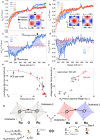Strong electron-phonon coupling driven pseudogap modulation and density-wave fluctuations in a correlated polar metal
- PMID: 37723139
- PMCID: PMC10507017
- DOI: 10.1038/s41467-023-41460-x
Strong electron-phonon coupling driven pseudogap modulation and density-wave fluctuations in a correlated polar metal
Abstract
There is tremendous interest in employing collective excitations of the lattice, spin, charge, and orbitals to tune strongly correlated electronic phenomena. We report such an effect in a ruthenate, Ca3Ru2O7, where two phonons with strong electron-phonon coupling modulate the electronic pseudogap as well as mediate charge and spin density wave fluctuations. Combining temperature-dependent Raman spectroscopy with density functional theory reveals two phonons, B2P and B2M, that are strongly coupled to electrons and whose scattering intensities respectively dominate in the pseudogap versus the metallic phases. The B2P squeezes the octahedra along the out of plane c-axis, while the B2M elongates it, thus modulating the Ru 4d orbital splitting and the bandwidth of the in-plane electron hopping; Thus, B2P opens the pseudogap, while B2M closes it. Moreover, the B2 phonons mediate incoherent charge and spin density wave fluctuations, as evidenced by changes in the background electronic Raman scattering that exhibit unique symmetry signatures. The polar order breaks inversion symmetry, enabling infrared activity of these phonons, paving the way for coherent light-driven control of electronic transport.
© 2023. Springer Nature Limited.
Conflict of interest statement
The authors declare no competing interests.
Figures





References
-
- Imada M, Fujimori A, Tokura Y. Metal-insulator transitions. Rev. Mod. Phys. 1998;70:1039–1263. doi: 10.1103/RevModPhys.70.1039. - DOI
-
- Basov DN, Averitt RD, van der Marel D, Dressel M, Haule K. Electrodynamics of correlated electron materials. Rev. Mod. Phys. 2011;83:471–541. doi: 10.1103/RevModPhys.83.471. - DOI
-
- Gruner, G. Density waves in solids. (CRC press, 2018).
-
- Baldini, E. Nonequilibrium dynamics of collective excitations in quantum materials. (Springer, 2018).
-
- Sigrist M, Ueda K. Phenomenological Theory of Unconventional Superconductivity. Rev. Mod. Phys. 1991;63:239–311. doi: 10.1103/RevModPhys.63.239. - DOI
Grants and funding
LinkOut - more resources
Full Text Sources
Research Materials
Miscellaneous

